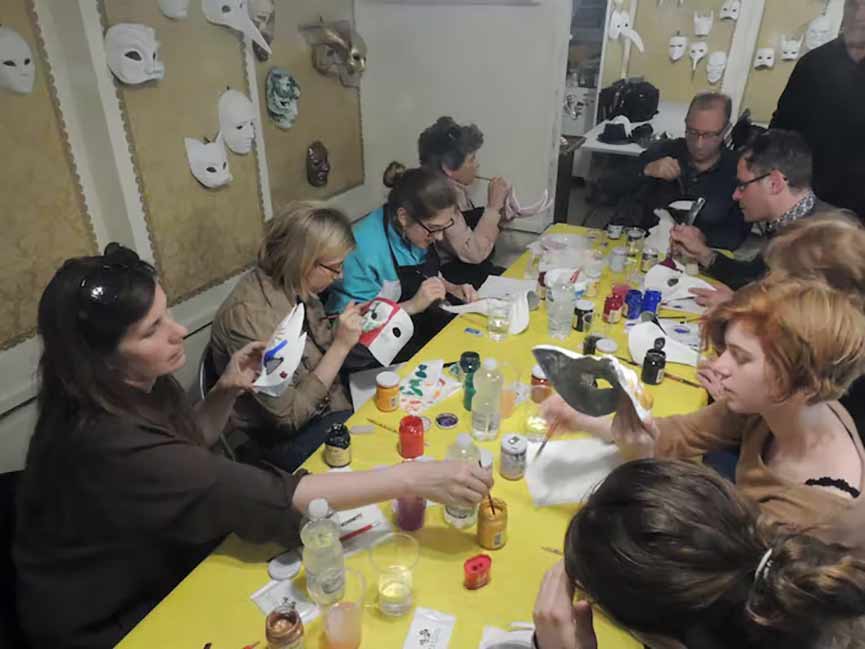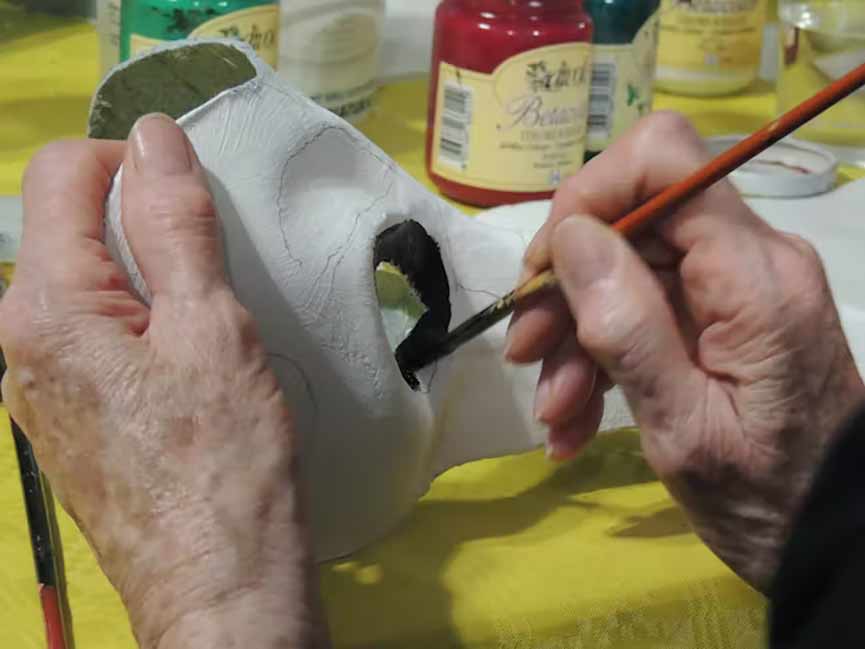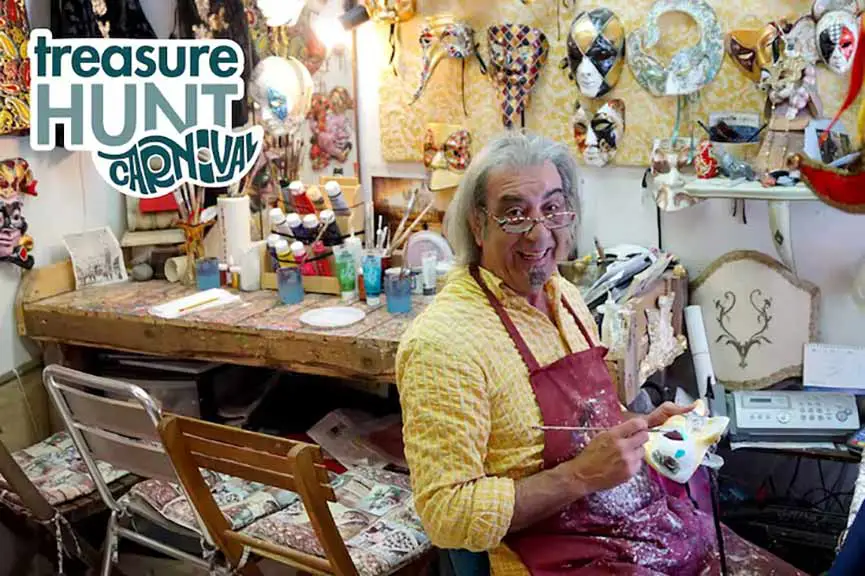
Venetian carnival mask workshop - Calle de le Erbe, 6423 - Venice
Venetian carnival mask workshop: € 75 per person.

What you will experience during the experience
– Create your own carnival mask.
– Learn the techniques from an expert guide.
– Decorate it with precious materials and take it with you.
– Duration of 2 hours.
Live a unique experience and create your own Carnival mask!
You will appreciate the magic of artisanal creation and the charm of cutting and shaping paper, following ancient stone moulds. An expert craftsman will guide and help you transform simple pieces of paper into a mask.
You will use fabric, colors, Swarovski crystals, gold leaf, feathers to create your unique and precious mask. At the end of the workshop, you will take your creation home, as a souvenir of an unforgettable experience.
What's included
– Workshop
– Hide
– Materials and decorations

Meeting point: Calle de le Erbe, 6423 - Venice


Main events of Venice Carnival
– The Venetian Festival on the water: the Festival on the Rio di Cannaregio between the Ponte dei Tre Archi and the Ponte delle Guglie has been held for years on the first day of Carnival. Here, on numerous festively decorated boats animated by acrobats and accompanied by music, an evocative representation takes place which attracts thousands of people to the banks of the Canaregio Canal. It is recommended to arrive early and give up if you are late to avoid getting stuck in the streets that lead to the Rio di Canaregio.
– Carnival opening regatta: the traditional regatta that opens the Carnival takes place the day after in the morning. At 11.00 a procession of festively decorated boats leaves from Punta della Dogana passing through the Grand Canal to reach the Guglie and the Tre Archi bridge in Canaregio. Upon arrival of the boat procession, the food and wine stands open and the party begins on the banks. The products of the Venetian tradition are offered to the public: fritole, galani, cicheti veneziani.
– Procession and Festa delle Marie: one week after the opening of the Carnival, one of the most famous events takes place: the Festa delle Marie. A procession in historical costumes leaves from San Pietro di Castello at 2.30 pm and reaches Via Garibaldi, Riva degli Schiavoni and Piazza San Marco where the Maries go up on stage for the presentation to the public. The Maries are 12 girls chosen from among the townspeople to commemorate the homage that the doge bestowed on 12 beautiful Venetian girls of humble conditions by giving them a dowry for their wedding. In addition to the historical procession, the event includes a real beauty contest with the proclamation of the most beautiful Maria at the end of the Venice Carnival.
– Flight of the Angel: on the Sunday after the Festa delle Marie, a classic of the Venice Carnival takes place in Piazza San Marco: the Flight of the Angel. Preceded by a procession of masks with the doge at the head, the event sees a figure descending from the 100 meters of the San Marco bell tower to the stage located in the square between the Procuratie, in front of the entrance to the Correr. Over the years, the protagonist of the Flight of the Angel has seen famous starlets and sportswomen take turns in the descent; for some years it has been the Maria who won the previous year to become an Angel for a day. The event officially opens the Carnival celebrations.
– The Most Beautiful Mask Competition: immediately after the Flight of the Angel, which officially opens the Carnival stage, the masks begin to parade in Piazza San Marco. The competition is open to all those who want to parade in masks and it is the public present in the square who decree, with direct elimination, the winners of each day. The event includes two daily competitions, in the morning and in the afternoon. Online registrations.
– The flight of the eagle: on the Sunday before Shrove Tuesday another flight has been taking place for years, the Flight of the Eagle in Piazza San Marco. The event starts at 11.00 and sees a character from the entertainment or society as the protagonist descending from the bell tower towards the stage where celebrations and masked parades follow.
History of the Carnival of Venice
The term would derive from the Latin phrases carnem levare or carne levamen which mean "to remove the meat", with reference to Shrove Tuesday as the last possible day to devote oneself to sumptuous lunches before the usual food deprivations during the period of Lent. A feast therefore linked to Christian and Catholic worship it seems, even if it is almost certain that the tradition dates back to the Greek and Roman period and was absorbed - like many other social and political aspects of the ancient world - by the subsequent Christian society. Just think of the Saturnalia Festival, which was held in Rome from 17 to 23 December and which was characterized by an overthrow of the social order in which slaves became free, dined with their masters who also became servants. And there was no shortage of masks and divinity disguises.
The same suspension of established social rules can be found in the Venetian Carnival which appeared in historical documents starting from 1094, when in a document by Doge Vitale Falier the term Carnival is reported and a show aimed at public amusement is mentioned. In the following years, citizens of all classes crowded the calli of Venice, almost always masked to free themselves from any social convention.
"Buon giorno siora maschera". It was the simple and equal greeting for everyone that citizens addressed in the city.
Shortly afterwards, an edict of the Senate of the Republic declared the period preceding Lent a holiday; in fact, Carnival lasted from December 26 until the day before Ash Wednesday, which became Shrove Tuesday.
In these days it was possible to go around Venice masked and it was allowed to put the aristocratic power in the sedan that assumed all the political offices. In fact, if we look at the date, 1296 precedes by only one year the Serrata del Maggior Consiglio in which the noble patricians excluded the people from public administration.
After all, the distraction of the masses with public spectacles and the possibility of an outlet for discontent, by allowing a temporary public derision of power, have always been a powerful weapon in the hands of those who exercise, and want to preserve, power.
However, the exercise of this freedom was not exempt from trespassing in the field of illegality - with muggings, robberies, harassment and rapes - and so from 22 February 1339 the Senate decreed the nocturnal ban on circulating in masks and in the following century, on 24 January 1458, the ban also arrived on entering sacred places dressed as religious to prevent libertine acts from being carried out with the nuns.
In the same way it was forbidden to carry weapons under the disguise and to exercise prostitution outside the free zones established in the city (such as the famous Castelletto di Rialto) taking advantage of the mask; the penalty was banishment for 4 years from Venice after being publicly whipped in Piazza San Marco.
The arrival of the French in the city in 1797, who decided to cede Venice to the Austrians with the Treaty of Campoformio (October 17, 1797) but not before having stripped it of every possible good, determined the end of the Carnival and the ban on wearing masks in public; a decision taken in a climate in the city of strong aversion to the French rulers first, and to the Austrian ones after January 18, 1798.
The rebirth of the Venice Carnival took place by decision of the city municipality which in 1979 re-established public celebrations, accompanied by a rich program of events which since then has never ceased to attract hundreds of thousands of visitors to the city from all over the world in every edition. |
